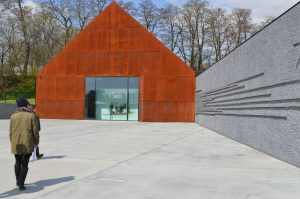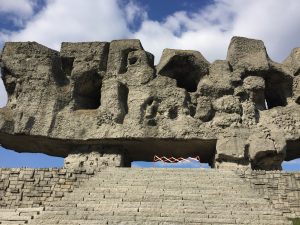HMDT Blog: March of the Living 2017 Part Two
Jamie (Team Assistant) and Rachel (HMD Development Manager) from the HMDT staff team recently took part in March of the Living UK, a six-day international educational trip which includes visits to former concentration camps and culturally significant sites associated with the Holocaust.
The programme culminates in an international march from Auschwitz I to Auschwitz-Birkenau, the two main sites of the largest Nazi extermination and concentration camp. Holocaust Memorial Day is marked on 27 January, the anniversary of the liberation of the camp. This is the second of two blogs about their experiences.
March of the Living UK isn’t solely an opportunity to explore what happened during the Holocaust itself. The five-day intensive programme also enables participants to examine pre-war and post-war Jewish life, as well as exploring more widely what happened in Poland during World War Two. During this period, the Nazis and their collaborators murdered millions of people, including Jews, Poles, homosexuals, Roma and Sinti people, disabled people, and many more – anyone who didn’t fit into their Aryan ideals. Having a focus on pre-war Jewish life enables participants on March of the Living UK to get a deeper understanding of what was lost in the Holocaust. It’s hard to cover everything we saw, experienced and learnt into one blog so instead, we’ve decided to focus on two places we visited, Markowa and Majdanek, before looking at Jewish life in Poland today.
The Holocaust
In Markowa we visited Poland’s first museum dedicated to ‘Righteous Among the Nations’ – people who aided Jews during the Holocaust. The title is bestowed by Yad Vashem to honour those who risked their lives to save Jews: 26,513 people have been honoured this way, with 6,706 of these from Poland.
The museum in Markowa shares the story of Józef and Wiktoria Ulma who hid eight Jews in their home during the Holocaust. The police were informed and the Ulma’s house was surrounded by the Nazis. All the Jews were shot, then Wiktoria, who was 9 months pregnant, Józef, and lastly their six young children as a punishment and a warning to others not to hide Jews. 
The deterrent worked. The morning after, 24 corpses of Jews were discovered in the fields, as some of the local peasants who had been hiding Jews (some as long as 20 months) had taken matters in their own hands. Others continued to hide Jews, who then survived to tell the Ulmas’ story. This poignant, moving and informative museum, which includes a memorial wall to all those from the region who risked their lives to hide Jews, demonstrates the bravery of some Poles, and the real danger they faced.
Not many people visit the former concentration camp at Majdanek; 210,000 people visited the state museum in 2016, compared to 2,053,000 people who visited Auschwitz state museum in the same year. Auschwitz’s proximity to Krakow, a popular tourist destination, may go some way to explaining the vast numbers of visitors.
Auschwitz has become a distinct symbol of the Holocaust, and its foreboding entrance gates are widely recognisable. However, Auschwitz alone doesn’t represent the enormity and complexity of the Holocaust which took place across Europe and we were very grateful for the opportunity to visit Majdanek to see the site for ourselves.
More than 1.1 million people were murdered at Auschwitz; there is not a consensus of how many people were murdered at Majdanek, estimates range from 80,000 to 300,000 people.
Majdanek’s proximity to Lublin: to apartment blocks, to houses, to roads, is frightening; ostensibly because it was first built as a POW camp, but no doubt it would have also served as a deterrent to locals warning them to toe the line. Not as much is known about Majdanek as the five other death camps in Poland. There were gas chambers as Majdanek, but prisoners also died through starvation, disease, beatings, injections, hangings and firing squads. On 3 November 1943, 18,000 Jews from Majdanek camp were murdered following an uprising at Sobibor extermination camp. Halina Birenbaum, who survived both Auschwitz and Majdanek said that her greatest duty was to ‘tell others how much people [in the camps] had wanted to live’.
It’s still difficult to grasp the enormity of the Holocaust, but we know Halina lost most of her family, parents and siblings. By raising awareness of their murders we help highlight that they were individuals who wanted to live but who had their lives taken away from them.
 Jewish life Today
Jewish life Today
One aspect to March of the Living is to seek to understand the effect of the Holocaust on Polish Jewry. Around 90 % of the Jewish population of Poland was wiped out by the Nazis and their collaborators.
After the atrocities of the Holocaust, there were a huge number of challenges for those looking to rebuild a community in Poland. Would the Jewish population be able to live side-by-side with the non-Jewish Polish population? Bringing together those who had suffered at the hands of the Nazis in cities where they had previously lead rich and fulfilling lives was an immensely difficult task.
With this in mind, we visited Jewish Community Centres (JCC) in Warsaw and Krakow, in order to understand Polish Jewish life today. What we found were thriving community hubs, at the heart of their cities. Despite facing challenges along the way, people we met with were filled with positivity and a bright outlook for the future.
We met four young women who are part of the team introducing Jewish life and culture to Warsaw’s estranged Jewish youth, utilising their inviting café style space in the city’s downtown, just outside the borders of the former Warsaw Ghetto. Discussing their involvement with the JCC, the women cited several reasons for their ongoing participation in the Warsaw Jewish Community: including trying to build a new community in memory of the thriving one destroyed during the Holocaust, and offering support to those discovering their Jewish heritage.
The team also spoke candidly about the challenges they face, including the slow uptake in participation in the services they offer. Some asked questions about the appropriateness of the work they were doing; did they think Jewish yoga was relevant? Undeterred by the difficulties they face, the team at this enterprising centre is willing to try anything that can engage the Jewish youth.
The JCC is inviting and personable. Its glass walls allow people to see the activities going on inside. We hear how the coffee shop style ground floor has become a local haunt for young people and adults alike.
It is clear just how much the community means to those involved. As we sit listening, we hear people chatting and laughing upstairs. Although this community is small, it is slowly gaining traction. As it grows, the spirit of Polish Judaism is rekindled.